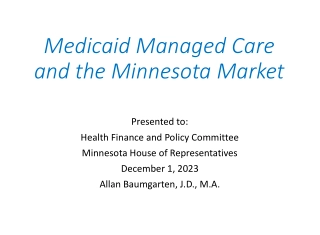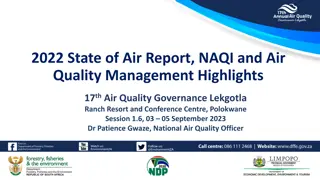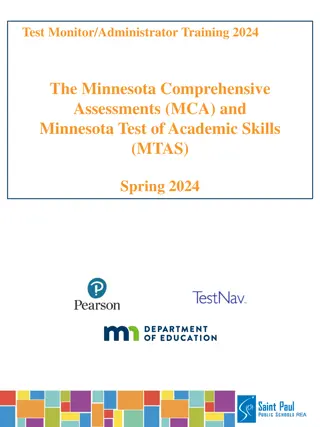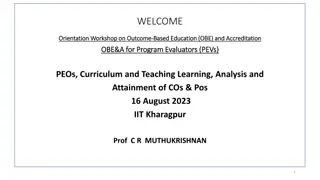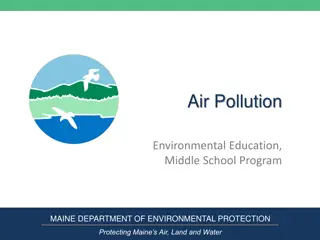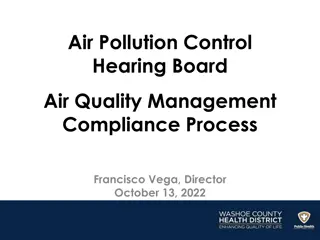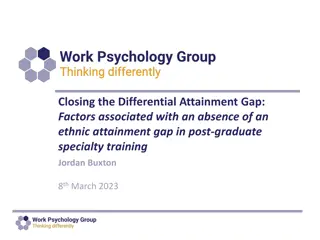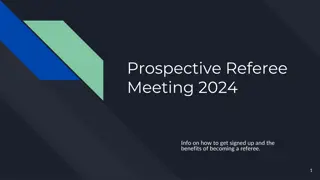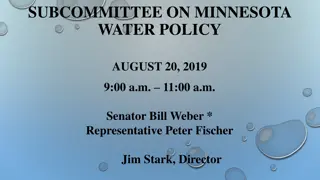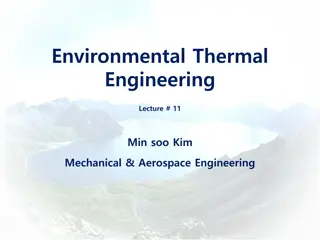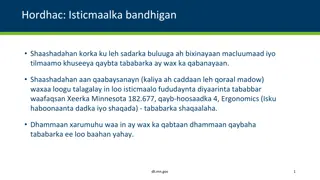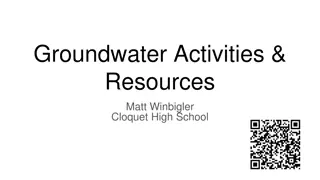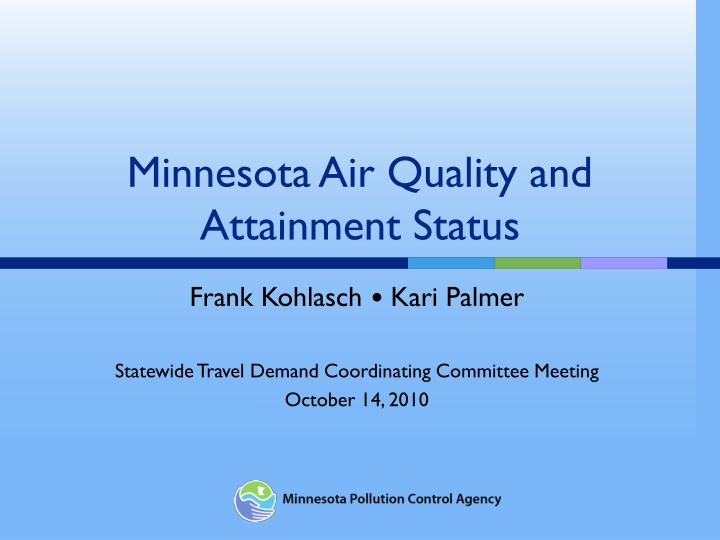
Minnesota Air Quality Standards and Implementation Plans
Learn about the National Ambient Air Quality Standards (NAAQS) set by the EPA to protect human health, ongoing reviews of pollutants, State Implementation Plans (SIPs), and the basics of SIPs, impacting Minnesota's air quality regulations.
Download Presentation

Please find below an Image/Link to download the presentation.
The content on the website is provided AS IS for your information and personal use only. It may not be sold, licensed, or shared on other websites without obtaining consent from the author. If you encounter any issues during the download, it is possible that the publisher has removed the file from their server.
You are allowed to download the files provided on this website for personal or commercial use, subject to the condition that they are used lawfully. All files are the property of their respective owners.
The content on the website is provided AS IS for your information and personal use only. It may not be sold, licensed, or shared on other websites without obtaining consent from the author.
E N D
Presentation Transcript
Minnesota Air Quality and Attainment Status Frank Kohlasch Kari Palmer Statewide Travel Demand Coordinating Committee Meeting October 14, 2010
Summary National Ambient Air Quality Standards (NAAQS) State Implementation Plans (SIPs) Pollutants of concern for transportation Carbon dioxide (CO) Nitrogen oxides (NOX) Ozone Fine particles (PM2.5) Impacts
NAAQS Basics Primary standards are set to protect human health Secondary standards are set to protect public welfare Set for six criteria pollutants SO2 Ozone Particles (PM10 and PM2.5) CO, Lead NOX
NAAQS Revisions EPA must periodically review each NAAQS NAAQS must protect human health with an adequate margin of safety Costs cannot be considered in setting the level Between 2008 and 2012, EPA will review ALL Reviews often result in lower standards and shorter averaging times Some level of regulatory uncertainty during transition
Ongoing NAAQS reviews: Pollutant Milestone NO2/SO2 Secondary NO2 Primary SO2 Primary Lead Ozone CO PM Timeline Oct 15, 2008 Jan 22, 2010 Oct 31, 2010 May 13, 2011 Mar 20, 2012 Jun 2, 2010 July 2011 NOTE: Underlined dates indicate court-ordered or settlement agreement deadlines.
State Implementation Plan (SIP) Demonstrates how a state will attain the NAAQS Contains state rules/statutes, programs, and site-specific requirements
SIP Basics SIPs apply to nonattainment and attainment areas Nonattainment SIPs have specific requirements Nonattainment area must include the air that does not meet the standard and all sources that contribute to nonattainment Transportation conformity takes effect one year later An attainment SIP must be developed
SIP steps Legal Authority Air Quality Monitoring Control Strategy Demonstration Resources State Emission Limiting Rules and Regs Implementation Modeling data Plan (SIP) Enforcement New Source Review Voluntary and Non-traditional Mobile Measures and Fuels Permitting Permitting Measures Taken from presentation by Tom Helms, EPA, on nonattainment/SIP
Implementing a New NAAQS EPA sets a new standard Immediate impact on facility review Additional monitoring often required 1 yr States make a designation recommendation EPA makes a final designation 1 yr 1.5 yrs 1 yr Attainment must be shown (5 years after designation) States submit SIP demonstrating attainment Transportation conformity applies
CO NAAQS CO NAAQS is being reviewed Available background documents to support the review The evidence provides support for a standard at least as protective as the current standard Schedule is court ordered Notice of proposed rule to be signed October 28, 2010 Notice of final rule to be signed May 13, 2011
Twin Cities CO Trends 1998 2009 One Hour Design Value Trends 1998 2009 Eight Hour Design Value Trends 9 15 Potential standard range of 3-9 ppm 2nd highest 8-hr max CO (ppm) Potential standard range of 5-15 ppm 2nd highest 1-hr max CO (ppm) 8 12 7 6 9 5 4 6 3 2 3 1 0 0 FHR 420 FHR 423 FRIDLEY ST PAUL MPLS ST CLOUD DULUTH
NOx NAAQS New standard of 100 ppb, one hour average Annual 53 ppb standard remains effective EPA focused on near roadway concentrations New roadway monitors being required (by 2013) Areas without monitors will be designated as unclassifiable Nonattainment designations not likely until 2016 or 2017
NO2 annual average trends 60 NO2 Standard 50 Mean Annual NO2 (ppb) 40 FHR 420 FHR 423 BLAINE 30 20 10 0
NOx and Secondary Formation Reductions may be needed even if Minnesota attains the NAAQS Important component of secondary formation VOCs + NOx + sunlight = ozone Ammonia + NOx = ammonium nitrate (~ of fine particle mass)
Ozone NAAQS The final NAAQS scheduled for October 2010 Current standard: 75 ppb (set 2008) Proposed levels: 60 70 ppb Key Issues Shorter timeframe for designations (June 2012) What data will be used for designations?
Ozone NAAQS Design Values (DVs) 8-Hour Ozone DVs, 2007-2009 Estimated 8-Hour Ozone DVs, 2008-2010 Data through August 23, 2010 80 80 75 75 70 70 67 Range of Proposed Standard Range of Proposed Standard 65 65 64 64 65 65 63 62 62 62 62 62 61 61 60 60 60 60 60 60 60 60 59 60 59 60 58 58 58 57 57 55 55 55 55 55 52 50 50 45 45 40 40
Sources of Ozone (2005 data) Nitrogen oxides Volatile organic compounds
Ozone Nonattainment Based on prior EPA implementation guidance Ozone nonattainment has different levels Marginal/moderate/serious/severe An area s classification will affect SIP requirements SIP Required Elements Reasonably available control measures/technology (RACM/RACT) Vehicle Inspection/Maintenance (I/M) Reasonable further progress (RFP) EPA will propose implementation guidance when they finalize the standard
Fine Particulate Matter (PM2.5) PM2.5 is both primary and secondary Secondary Particles (From Precursor Gases) Primary Particles (Directly Emitted) VOC Condensed Organics Secondary Organics Elemental Carbon SO2 Ammonium Sulfate Crustal Ammonia Ammonium Nitrate Crustal Other NOx June 2000 / tgp
PM2.5NAAQS Design Values (DVs) Estimated Daily PM2.5 DVs 2008-2010* Data through March 2010 Annual PM2.5 NAAQS DVs, 2007-2009 40 Range of Proposed Standard 35.936.5 12 Current Standard 35 10.9 10.3 31 31 10 30.5 9.9 9.9 9.6 10 9.5 29.1 28.6 30 8.7 26.5 25 8 7.5 21.8 19.7 6.4 20 5.8 6 15.3 15 4 10 2 5 0 0
New PM2.5 Standard Will be proposed and finalized in 2011 EPA will likely wait for this new standard to designate us as nonattainment State designation recommendation likely December 2012 Based on 2009 2011 data? Designation likely in December 2013 Based on 2010 2012 data?
Trend in Daily PM2.5 Design Values Metro Sites 50 45 Concentration ( g/m3) Apple Valley Richfield Mpls - Phillips Mpls - Humboldt Ave St. Louis Park St. Paul - RRR St. Paul - RHC St. Paul - Harding Shakopee 40 35 30 25 20 15 10 2000 2001 2002 2003 2004 2005 2006 2007 2008 2009 Note: actual design value is 3-yr average
Trend in Annual PM2.5 Design Values Metro Sites 14 13 Apple Valley Richfield Mpls - Phillips Mpls - Humboldt Ave St. Louis Park St. Paul - RRR St. Paul - RHC St. Paul - Harding Shakopee 12 Concentration ( g/m3) 11 10 9 8 7 6 2001 2002 2003 2004 2005 2006 2007 2008 2009 Note: actual design value is 3-yr average
Sources of PM2.5 Initial Estimate - Sources of Ambient PM2.5 (adapted from MN PM2.5 Source Apportionment Study by Desert Research Institute ) Other 12 Biomass Burning Average Source Contribution to 10 Calcium Material Soil/Dust 8 Mobile (gasoline & diesel) PM2.5 (ug/m3) Secondary Ammonium Nitrate 6 Secondary Ammonium Sulfate Secondary Ammonium Sulfate - SO2 from coal; ammonia from livestock & fertilizer 4 Secondary Ammonium Nitrate - NOx from coal & mobile sources; ammonia from livestock & fertilizer 2 0 Biomass burning - More study needed Mille Lacs Rochester Rural SW Rural SE Northeast Twin Cities Mobile - May include small amounts of other oil combustion & secondary organic aerosol Chen, L.-W. A.; Watson, J. G.; Chow, J. C.; DuBois, D. W.; Herschberger, L. Chemical mass balance source apportionment for combined PM2.5 measurements from U.S. non-urban and urban long-term networks. Atmos. Environ. 2010, in press.
Impacts MPCA team formed to work on ozone and PM2.5 issues Modeling, monitoring, policy Changes in standards likely mean changes to business as usual More things to look at when permitting a new or expanding source More pollutants subject to transportation conformity More likely that existing source emissions will be examined and mitigated May move into the world of Lowest Achievable Emission Rate (LAER) and offsets
Frank Kohlasch Frank.Kohlasch@state.mn.us 651-757-2500 Kari Palmer Kari.Palmer@state.mn.us 651-757-2635 Thanks to MPCA staff Catherine Neuschler Cassie McMahon Lisa Herschberger

